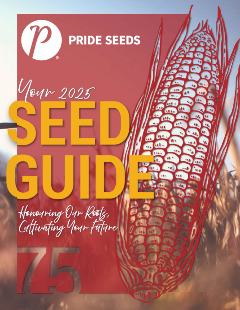Browse our selection of products below
___________________________________________________________________________________________________________________________________________

2024-2025 PRIDE Seeds Product GuideYou can find all of our products on the website, including supporting performance data and create your own personalized guide called My Guide. You can also download the digital version of our printed product guide which includes product comparison charts. |
Enhance your knowledge and stay ahead with PRIDE SEEDS Corn and Soybean School videos.
SHOP THE PRIDE SEEDS E-STORE
-7.png?sfvrsn=87920db3_3)
STAY UP-TO-DATE WITH PRIDE SEEDS LATEST BLOGS, NEWS AND ARTICLES
Corn Ear Moulds and Mycotoxins
For corn, 2018 is likely to be remembered as the year of ear moulds and the associated mycotoxins. Some counties (eg. Haldimand and Niagara) were not as severely impacted by this issue as others, but the issue was felt to some degree across all of Southwestern Ontario. The dire economic consequences of this issue has the attention of all corn producers as they evaluate strategies to avoid the issue in future crops.
In order for infection to occur, there must be three factors in place; conducive weather, a disease organism and a host crop. Weather was the biggest factor for the problem. Precipitation and persistent moisture at and around pollination allowed infection to take place and continued damp conditions into the fall (recall how challenging soybean harvest was!) allowed the fungal infections to spread across the cob.
There are numerous ear moulds that can infect corn and produce mycotoxins, but in 2018 Gibberella was the dominant challenge (with the associated mycotoxin deoxynivalenol – DON).
Unfortunately, this disease is very common in the Great Lakes basin of Southern Ontario, as this disease overwinters on crop residues, releasing spores when conditions are most conducive. In 2018, for much of Southern Ontario, the conditions were favourable for the release of spores at pollination time and infection occurred.
Corn is the host crop of concern, although Gibberella is the same disease organism that causes Fusarium Head Blight in cereals. As mentioned above, weather at pollination was crucial for infection, but as plots came off, as well as whole fields, it became apparent there were genetic differences in hybrid susceptibility.
Based on the vast number of samples taken by PRIDE Seeds representatives (both on our hybrids and competitors) we found there were a few hybrids that had consistently lower levels of infection and associated mycotoxins, plus a handful that had higher levels of infection.
The majority of hybrids fell somewhere in between, with infection levels that varied based on pollination timing and associated weather at the given location. The Ontario Corn Committee also ran mycotoxin screening of the OCC trials, and found similar results of some hybrids with high levels of infection, some with low levels and the majority somewhere in between. This information can be found at www.gocorn.net.
If you have any questions on hybrid susceptibility to ear molds and associated mycotoxins please reach out and let us know. There was also some association between management and/or stress on the corn crop and infection.
Typically, most of the ears that displayed infection were smaller than average, which is believed to be due to some stress early in the season; shallow planting, insect damage to seedling, compacted soil, lack of fertility etc. Simply put, anything that resulted in a stressed plant produced a smaller cob with increased incidence of infection. Population played a critical role as well, and if the population was too high, cobs were prone to tip back and infection levels tended to increase.
If the population was too low, there was an increase in plants with second cobs, and second cobs are generally undersized and at higher risk of ear mold infections.
Population is always a lengthy discussion, as it varies by hybrid, but also field conditions and grower management. However, we know aiming for the right populations helps maximize economics, and have seen how it can impact ear mold infection rates, so if you have any questions on population for your chosen hybrid please let us know. 
Going into 2020 and beyond, it is important to recognize that the diseases that cause ear molds are in our environment and if weather conditions are conducive, infections can occur.
Hybrid selection is important, especially staying away from higher risk hybrids, but so is growing a wider range of varieties. This helps spread out the pollination dates so that not all your eggs are in the same ‘weather basket,’ which is also a sound strategy for yield management. Attention should also remain focused on growing the best crop possible, aiming to provide conditions that eliminate stress and the associated small ears.
As well, take some time to review your seed drop, taking into account the hybrid, the growing environment (soil texture, drainage, etc.) and the fertility program, and lastly, a little luck that the weather cooperates!
TAKE PRIDE IN YOUR INBOX
Expert advice, news and information
THE PRIDE SEEDS ADVANTAGE
Farming is one of the most demanding industries in the world, subject to a variety of factors such as time, weather, and global pressures. You know this every time you look out the window and think about the field in front of you. Growers and dealers deserve an advantage: The PRIDE Seed Advantage.
LEARN MORETHE PRIDE SEEDS ADVANTAGE
Every year PRIDE Seeds works hard to produce leading-edge products that enable success where it matters most, on your farm. Our dedicated team strives to provide sales expertise, agronomy support, quality production, and service tailored to meet your needs.
LEARN MORE

Leave a commentOrder by
Newest on top Oldest on top